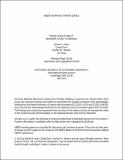Trade Adjustment: Worker-Level Evidence
Author(s)
Dorn, David; Hanson, Gordon H.; Song, Jae; Autor, David H
DownloadAutor_Trade adjustment.pdf (961.0Kb)
OPEN_ACCESS_POLICY
Open Access Policy
Creative Commons Attribution-Noncommercial-Share Alike
Terms of use
Metadata
Show full item recordAbstract
We analyze the effect of exposure to international trade on earnings and employment of U.S. workers from 1992 through 2007 by exploiting industry shocks to import competition stemming from China’s spectacular rise as a manufacturing exporter paired with longitudinal data on individual earnings by employer spanning close to two decades. Individuals who in 1991 worked in manufacturing industries that experienced high subsequent import growth garner lower cumulative earnings, face elevated risk of obtaining public disability benefits, and spend less time working for their initial employers, less time in their initial two-digit manufacturing industries, and more time working elsewhere in manufacturing and outside of manufacturing. Earnings losses are larger for individuals with low initial wages, low initial tenure, and low attachment to the labor force. Low-wage workers churn primarily among manufacturing sectors, where they are repeatedly exposed to subsequent trade shocks. High-wage workers are better able to move across employers with minimal earnings losses and are more likely to move out of manufacturing conditional on separation. These findings reveal that import shocks impose substantial labor adjustment costs that are highly unevenly distributed across workers according to their skill levels and conditions of employment in the pre-shock period. JEL Codes: F16, H55, J23, J31, J63.
Date issued
2014-09Department
Massachusetts Institute of Technology. Department of EconomicsJournal
The Quarterly Journal of Economics
Publisher
Oxford University Press
Citation
Autor, D. H., D. Dorn, G. H. Hanson, and J. Song. “Trade Adjustment: Worker-Level Evidence.” The Quarterly Journal of Economics 129, no. 4 (September 24, 2014): 1799–1860.
Version: Original manuscript
ISSN
0033-5533
1531-4650